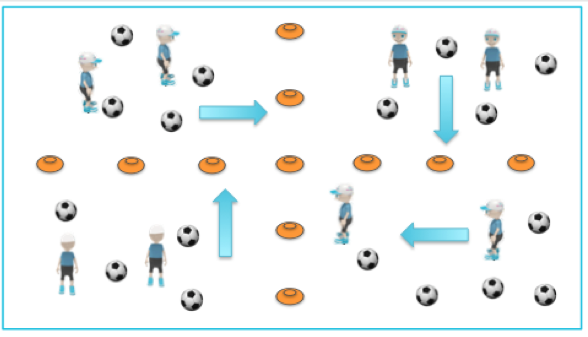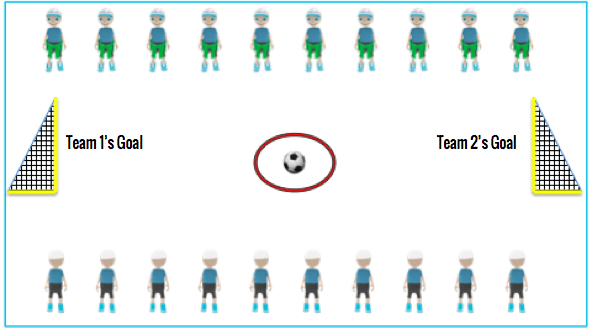TECHNIQUE
Today we are going to learn how to pass off the dribble at a target.
IMPORTANCE
Passing off the dribble at a target is important because it allows you to quickly move the ball to where you cannot dribble and keeps the ball in your possession.
VOCABULARY
Plant foot: the foot that is on the ground when a kick is made.
When passing off the dribble at a target, it is important to:
1. Place your plant foot next to the ball pointed towards the target.
2. Lock your ankle and keep your passing toe up.
3. Swing the inside of the kicking foot through the middle of the ball. For moving targets, pass the ball where the receiver will be (leading).
PRACTICE
- Move onto Skills Game – Pinball Machine.
PINBALL MACHINE
TIME
10-20 minutes
NUMBER OF STUDENTS
4-30 students per game
EQUIPMENT
10 short cones
16 soccer balls
STORYLINE
Today we are playing Pinball Machine. Your goal is to have as few soccer balls as possible in your team's rectangle by passing off the dribble at another team's rectangle.
INSTRUCTIONS
- Before the game begins, I will divide the class into four teams.
- When I say, “GO!” kick the balls in your rectangle to the rectangle right of you.
- If you kick the ball too hard and it goes out-of-bounds, you must retrieve it.
- At the end of two minutes, we will count how many balls are left in your rectangle.
- We will begin a new round when all the balls have been counted.
Game 1: Play as indicated above. Each team kicks balls to the rectangle to the right of them.
Game 2: Each team kicks balls to the rectangle to the left of them.
Game 3: Each team kicks balls to the rectangle across them.
Game 4: Each team kicks balls to any rectangle.
Exit Ticket: Students pass off the dribble to the teacher to put the soccer balls away.
TEACHING TIPS
- Approach:
- Remind students that communicating with their classmates is very important to be successful in this game.
- Divide teams equally based on athletic ability.
- ELL Accommodation:
- Post labeled pictures of skills and game play.
- Partner with proficient English speakers for directions/modeling and reflections.
- SpEd Accommodation:
- Set individual goals for physical or behavioral modifications.
- Allow students to demonstrate skill one-on-one with teacher.
- Allow students extra time to master the skill.
- Reflection:
- What part of your foot should you use when passing the ball?
- Why might passing the ball to a moving target be more difficult than passing to a stationary target?
TEAM SOCCER TAG II
TIME
10-20 minutes
NUMBER OF STUDENTS
No restrictions
EQUIPMENT
1 soccer ball per team of 2
STORYLINE
Today we are playing Team Soccer Tag II. Your goal is to pass off the dribble at a teammate without getting tagged by the blob (tagger).
INSTRUCTIONS
- Before the game begins, I will divide the class into teams of two.
- Ro Sham Bo with your teammate to decide who will start with the ball first.
- When I say, “GO!” move anywhere inside the boundary cones and start passing the ball back and forth to one another.
- You must pass the ball while moving.
- The blob will try and kick your ball out-of-bounds.
- If your ball goes out-of-bounds, both you and your teammate become part of the blob and must link arms or hold hands.
- We will begin a new game when there is only one team left.
Game 1: Play as indicated above. Teacher is the first blob.
Game 2: Student begins as the blob.
Exit Ticket: Students pass off the dribble to the teacher to put the soccer balls away.
TEACHING TIPS
- Approach:
- Remind students that communicating with your partner is very important to be successful in this game.
- ELL Accommodation:
- Post labeled pictures of skills and game play.
- Partner with proficient English speakers for directions/modeling and reflections.
- SpEd Accommodation:
- Set individual goals for physical or behavioral modifications.
- Allow students to demonstrate skill one-on-one with teacher.
- Allow students extra time to master the skill.
- Reflection:
- What part of your foot should you use when passing the ball?
- Why might passing the ball to a moving target be more difficult than passing to a stationary target?
STEAL THE BALL
TIME
15-25 minutes
NUMBER OF STUDENTS
No restrictions
EQUIPMENT
1 soccer ball
2 goals
1 hula-hoop
1 flag per 2 students
STORYLINE
Today we are playing Steal the Ball. Your goal is to steal the ball from the middle of the field and pass off the dribble at a teammate to score a goal in your opponent’s net.
INSTRUCTIONS
- I will divide the class into two teams. Each team will line up on their baseline.
- At the beginning of each round, I will call out two numbers (two students from each team).
- When your number is called, run to the center of the field and attack the ball.
- You must pass off the dribble to your teammate before shooting on goal. Once you have made one complete pass, you can shoot on goal.
- All GrowFit soccer rules apply.
- We will begin a new round when someone has scored a goal.
Game 1: Play as indicated above.
Game 2: Call out two or three numbers at a time.
Exit Ticket: Students pass off the dribble to the teacher to put the soccer balls away.
TEACHING TIPS
- Approach:
- Divide teams equally based on athletic ability.
- Clarify before the game starts, which goal each team is shooting at.
- ELL Accommodation:
- Post labeled pictures of skills and game play.
- Partner with proficient English speakers for directions/modeling and reflections.
- SpEd Accommodation:
- Set individual goals for physical or behavioral modifications.
- Allow students to demonstrate skill one-on-one with teacher.
- Allow students extra time to master the skill.
- Reflection:
- What part of your foot should you use when passing the ball?
- Why might passing the ball to a moving target be more difficult than passing to a stationary target?






